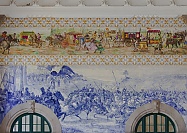One of the joys of visiting a historic city such as Porto in Portugal is that something as simple as a walk through the streets is a treat for the senses. The visual impact of the living architectural museum is evident whichever way you turn, no few places more so than at the Sao Bento Train Station.
The station is built on the site of an old Benedictine monastery, named Sao Bento de Ave Maria, dating back to the 16th century, though the original building burnt down in 1783 and its replacement was poorly cared for, it too finding itself in a serious state of disrepair at the end of the 1900s.
With the expansion of the railways, it was decided the site should be the new home of Porto's mainline station, and work began on the terminal building in 1900.
The first stone was laid by King Carlos I to underline his support of the project, the design of which was entrusted to the local architect, Jose Marques da Silva in French Beaux-Arts style.
Due to the sheer size of the project, Sao Bento Train Station was finally inaugurated in 1916. This was due not only to the physical size of the space but to the 20,000 traditional azulejos, or Portuguese tiles, which were used to adorn the interior. Laid between 1905 and 1916, the tiles were the work of Jorge Colaco, the most renowned tile painter in Portugal at the time.
These distinctive blue and white panels depict a series of scenes from Porto everyday life and history, from King Joao I and Queen Philippa of Lancaster standing by the cathedral in 1387 and Prince Henry the Navigator conquering Ceuta in Morocco, to a representation of the Battle of Arcos de Valdevez and the meeting of the Knight Egas Moniz and Alfonso VII of Leon in the 12th century.
Considering they are now a century old, the tiles have withstood the test of time superbly. The sight of the floor-to-ceiling decoration in 20,000 blue and white tiles is breathtaking when you enter the station, and no matter how many times you return their impact is undiminished.




